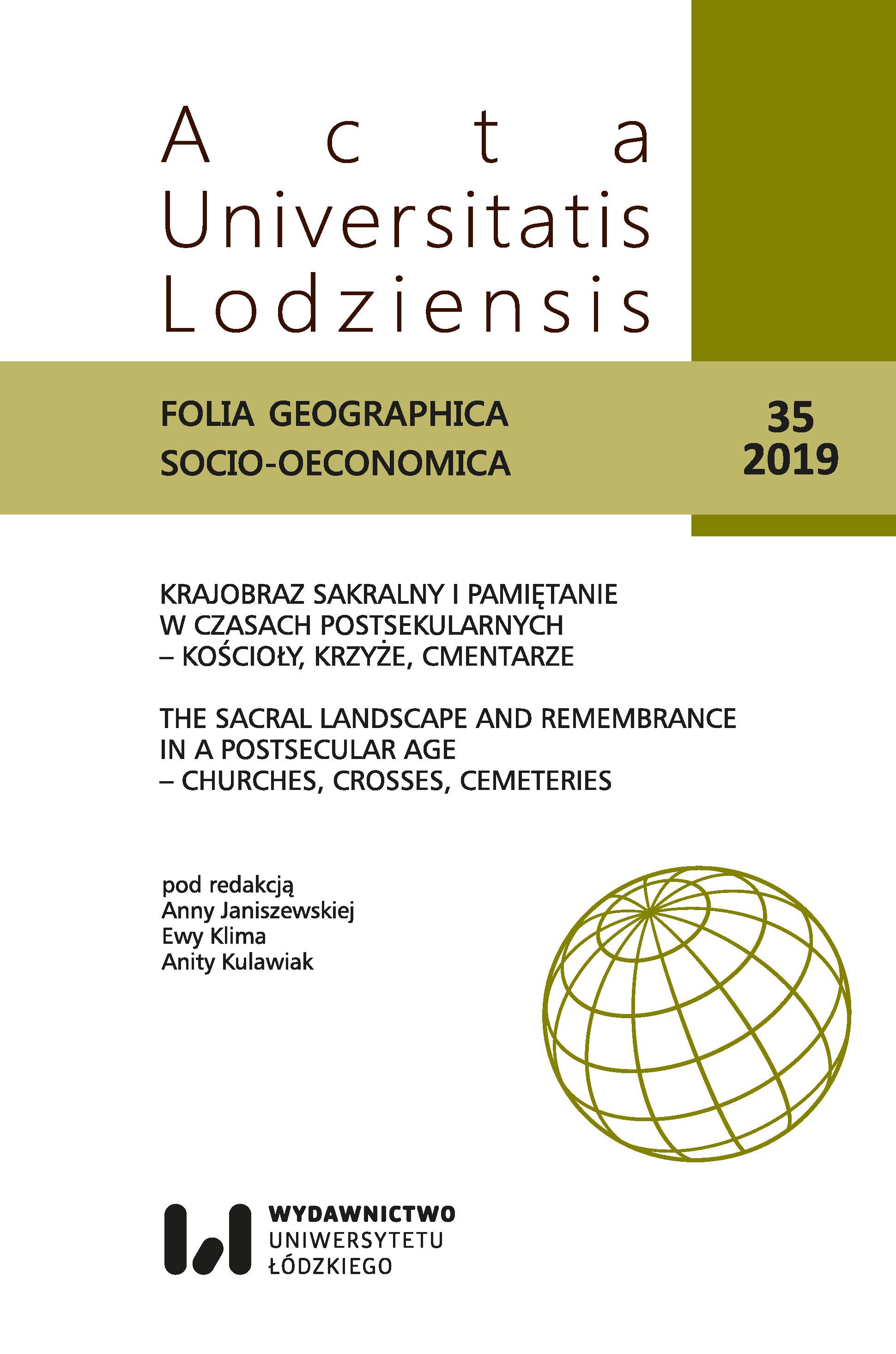Czas, przestrzeń i życie społeczne nowa interpretacja cmentarzy w mieście
DOI:
https://doi.org/10.18778/1508-1117.35.04Słowa kluczowe:
cmentarz, miejsce, przestrzeń, czas, poznanie, geografia człowiekaAbstrakt
W artykule poruszono problematykę czasu zapisanego w przestrzeni miejskiej, wyznaczającego specyficzny rytm, ciągłość i przemijanie kolejnych pokoleń oraz ich relacje społeczne. Zaprezentowano wyniki badań dotyczących postrzegania czasu w przestrzeni cmentarzy, które pozwalają lepiej zrozumieć nie tylko tożsamość tych miejsc w strukturze miasta, ale także czynniki kształtujące wyobrażenia jakie mają o nich mieszkańcy. Prowadzone badania miały głównie charakter jakościowy, wykorzystano metody analizy materiałów wizualnych (zdjęć) oraz pola semantycznego.
Wydaje się, iż wykorzystanie obrazu i słowa otwiera przed geografią człowieka nowe możliwości, nowe źródła eksploracji przestrzeni. Problem podjęty w tekście jest ważny zarówno z poznawczej, jak i praktycznej perspektywy związanej z odpowiednim kształtowaniem przestrzeni miasta – nowoczesnego, a jednocześnie niewykorzenionego z tradycji i tożsamości danego miejsca, w którym ludzie czuliby się dobrze, mogąc odnaleźć zarówno punkt odniesienia do przeszłości, jak i do przyszłości.
Bibliografia
Agnew J., 1998, Geopolitics: Revisioning World Politics, Routledge, London.
Google Scholar
Bajcar B., 2000, Wielowymiarowość osobistych koncepcji czasu, “Roczniki Psychologiczne”, 3: 71‒93.
Google Scholar
Crang M., 1997, Picturing practices: Research through the tourist gaze, “Progress in Human Geography”, 21: 359–373.
Google Scholar
DOI: https://doi.org/10.1191/030913297669603510
Crang M., 2001, Rhythms of the city: Temporalized space and motion, [in:] May J., Thrift N. (eds.), Timespace: Geographies of Temporality, Routledge, London: 187‒207.
Google Scholar
Eliade M., 2008, Sacrum i profanum. O istocie religijności, Wydawnictwo Aletheia, Warszawa [oryginalne wydanie: Le Sacré et le Profane, 1956].
Google Scholar
Klima E., 2011, Przestrzeń religijna miasta, Wydawnictwo Uniwersytetu Łódzkiego, Łódź.
Google Scholar
Leach E.R., 1950, Primitive Calendars, “Oceania”, 20 (4): 95‒97.
Google Scholar
DOI: https://doi.org/10.1002/j.1834-4461.1950.tb00164.x
Leach E.R., 1956, Primitive Time Reckoning, “A History of Technology”, 1: 110–127, [Singer C., Holmyard E.J., Hall A.R. (eds.)], Oxford at the Clarendon Press.
Google Scholar
Leach E.R., 1961, Rethinking Anthropology, Athlone Press, London.
Google Scholar
Lévi-Strauss C., 1969, Myśl nieoswojona, Warszawa.
Google Scholar
Lévi-Strauss C., 1970, Antropologia strukturalna, Warszawa.
Google Scholar
Lynch K., 1972, What Time is This Place?, MIT Press, Cambridge.
Google Scholar
Massey D., 1999, Space, time, “science” and the relationship between physical geography and human geography, “Transactions of the Institute of British Geographers”, 24 (3): 261‒276.
Google Scholar
DOI: https://doi.org/10.1111/j.0020-2754.1999.00261.x
Massey D., 2005, For Space, Sage, London.
Google Scholar
May J., Thrift N., 2001, Introduction, [in:] May J., Thrift N. (eds.), Time space: Geographies of Temporality, Routledge, London: 1‒43.
Google Scholar
Mordwa S., 2003, Wyobrażenia miast Polski Środkowej, Wydawnictwo Uniwersytetu Łódzkiego, Łódź.
Google Scholar
Pęckowska A., 2012, Pantha Rhei – Ruch i Czas w przestrzeni miejskiej, „Architektura. Czasopismo Techniczne”, 109 (1): 81–92, Wydawnictwo Politechniki Krakowskiej, Kraków.
Google Scholar
Robin R., 1980, Badanie pól semantycznych: Doświadczenia Ośrodka Leksykologii Politycznej w Saint-Cloud, [in:] Głowiński M. (ed.), Język i społeczeństwo, Warszawa: 1–252.
Google Scholar
Rose G., 2000, Practising photography: An archive, a study, some photographs and a researcher, “Journal of Historical Geography”, 26 (4): 555–571.
Google Scholar
DOI: https://doi.org/10.1006/jhge.2000.0247
Rose G., 2008, Using Photographs as Illustrations in Human Geography, “Journal of Geography in Higher Education”, 32 (1): 151‒160.
Google Scholar
DOI: https://doi.org/10.1080/03098260601082230
Schwanen T., 2009, Time-Space Diaries, International Encyclopedia of Human Geography, Elsevier Ltd.: 294‒300.
Google Scholar
DOI: https://doi.org/10.1016/B978-008044910-4.00547-2
Simonsen K., 1991, Towards an understanding of the contextuality of mode of life, “Environment and Planning D: Society and Space”, 9: 417‒431.
Google Scholar
DOI: https://doi.org/10.1068/d090417
Sztompka P., 2005, Socjologia wizualna, Wydawnictwo Naukowe PWN, Warszawa.
Google Scholar
Tobiasz-Lis P., 2016, Czas w przestrzeni miasta. Przykład Łodzi, Wydawnictwo Uniwersytetu Łódzkiego, Łódź.
Google Scholar
DOI: https://doi.org/10.18778/8088-379-6
Wallerstein I., 1998, The time of space and the space of time, the future of social science, “Political Geography”, 17 (1): 71‒82.
Google Scholar
DOI: https://doi.org/10.1016/S0962-6298(96)00097-2
Węcławowicz G., 1983, Geografia czasu, „Przegląd Zagranicznej Literatury Geograficznej”, 1, Instytut Geografii i Przestrzennego Zagospodarowania Polskiej Akademii Nauk.
Google Scholar
Pobrania
Opublikowane
Jak cytować
Numer
Dział
Licencja
Prawa autorskie (c) 2019 Acta Universitatis Lodziensis. Folia Geographica Socio-Oeconomica

Utwór dostępny jest na licencji Creative Commons Uznanie autorstwa – Użycie niekomercyjne – Bez utworów zależnych 4.0 Międzynarodowe.








